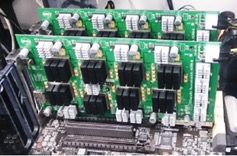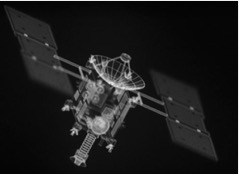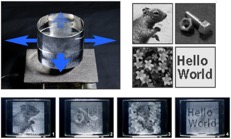NEXT-GENERATION THREE-DIMENSIONAL DISPLAY AND MEASUREMENT
FUTURE IMAGES MORE THAN MEETS THE EYE
-Advances in three-dimensional image display and measurement techniques have applications in multiple fields, from medicine to communication and entertainment.
Research Keywords: Computer Holography, Volumetric Display, High Performance Computing

Technologies based on three-dimensional (3D) image displays and holography may conjure up visions of science fiction, but the Next-generation Three-dimensional Display and Measurement program aims to make these advanced tools part of everyday life. Holograms create true three-dimensional images, which allow the viewer to see an object from all angles. They are created using coherent light sources such as lasers, which can store the complex light interference patterns required to accurately recreate an entire 3D object in full color. However, the main drawback of holography is the immense computational burden of producing high-quality holograms, not to mention creating moving 3D video images in real time.
Leader of the 3D program, Tomoyoshi Shimobaba says his team is developing ultrafast algorithms and dedicated computers for holography to create the world’s first real-time holographic 3D display system.
“These dedicated computers will have a computational speed three or four orders of magnitude higher than the household computers of today,” adds Tomoyoshi Ito, advisor on the project. “Based on this dedicated technology, we will investigate holographic projection,digital holographic microscopy and ultrarapid holographic imaging techniques.”
Among the team’s recent successes is a small, inexpensive, zoomable holographic projection system, suitable for use in classrooms, medical applications and entertainment products. Shimobaba’s team refined math- ematical image manipulation techniques to ensure a high-resolution, non-grainy holographic image even when zooming in and out. The researchers are further developing algorithms that can reduce ‘speckle noise’ in reconstructed images to avoid degradation in image quality.
ONE IMAGE, MULTIPLE VIEWS
Another aim is to reconstruct large 3D images with a large viewing angle — something that is difficult to realize using current technologies.
“We are also developing accurate holographic measurement systems, which will be invaluable in medical science because they allow researchers to image and measure samples in 3D alongside visualizing moving phenomena in real time,” explains Shimobaba.
In another exciting field of research, the team is exploring a form of 3D image creation called volumetric displays — the difference being that, while holograms can only be seen clearly by a few people at a time, volumetric displays can be viewed by multiple people from different viewpoints. And, in an even more challenging concept, they are trying to create multi-viewpoint images with plural information appearing in specific directions. In other words, one person standing at one place will see one piece of information, while another standing somewhere else will see completely different information.
“Our volumetric display simultaneously provides several observers with different information,” explains Shimobaba. “This very exciting feature is quite new, and we are considering new applications for using it, such as developing multi-language signage for the Tokyo Olympics in 2020,” he says. Such 3D displays may benefit from advanced aerial projection techniques, also under development by Shimobaba’s team. “Networking is the key to our success,” says Shimobaba. “Many students who have graduated from our laboratory move on to conduct research in academia or in private companies, and we continue to work with them. In this way, we expand our project and build fruitful working relationships across academia and industry.”
(CHIBA RESEARCH 2020)Members
Principal Investigator
| Name | Title, Affiliation | Research Themes |
|---|---|---|
| SHIMOBABA Tomoyoshi | Professor, Graduate School of Engineering | Electronic Image Engineering, Computer Technology |
Co-Investigatior
| Name | Title, Affiliation | Research Themes |
|---|---|---|
| KAKUE Takashi | Assistant Professor, Graduate School of Engineering | Optics |
| SHIRAKI Atsushi | Associate Professor, IMIT | Information Engineering |
| OKAMOTO Takashi | Specially Appointed Associate Professor, IGPR/Graduate School of Engineering | Optimization Theory, Artificial Intelligence |
| ITO Tomoyoshi | Professor, Graduate School of Engineering | Electronic Image Engineering |
| KOAKUTSU Seiichi | Professor,Graduate School of Engineering | Machine Learning |
| TAKAGAKI Michiko | Professor, Graduate School of Horticulture | Horticultural Crop Planting |
| SHIODA Shigeo | Professor,Graduate School of Engineering | Mathematical model,Stochastic model |
| YAMAMOTO Yota | JSPS Research Fellow,Graduate School of Engineering | Computer engineering,Field-programmable gate array |
Research report(2016〜2018)
We developed research on three-dimensional display and high-speed imaging using computer holography, and volume display. We accelerated these research greatly with the support of Chiba University's Institute for Global Prominent Research. We presented 68 peer-reviewed articles, including Nature Electronics.
 Figure 1. HORN-8 system
Figure 1. HORN-8 system
Figure 1 is a part of a dedicated computer system for computer holography (named HORN-8) that has been independently researched and developed by our group. We developed this board on which eight field programmable gate array (FPGA) chips with massive dedicated calculation circuits were mounted, and constructed a cluster system with eight HORN-8 boards. The computational speed is over 1,000 times faster than a current personal computer. Using the cluster system, a 100 million-pixel hologram is generated from a three-dimensional image composed of 10 million points, realizing the world's largest electronic holography reproduction. It was published in Nature Electronics (April 2018), and the reproduced image was adopted for the journal cover (Fig. 2).
Figure 1 is a part of a dedicated computer system for computer holography (named HORN-8) that has been independently researched and developed by our group. We developed this board on which eight field programmable gate array (FPGA) chips with massive dedicated calculation circuits were mounted, and constructed a cluster system with eight HORN-8 boards. The computational speed is over 1,000 times faster than a current personal computer. Using the cluster system, a 100 million-pixel hologram is generated from a three-dimensional image composed of 10 million points, realizing the world's largest electronic holography reproduction.
 Figure 2. Large-scale electronic holographic reproduction
Figure 2. Large-scale electronic holographic reproduction
It was published in Nature Electronics (April 2018), and the reproduced image was adopted for the journal cover (Fig. 2).
 Figure3. Directional volume display
Figure3. Directional volume display
It has received great responses, such as being taken up by domestic and international 30 media as opening the door of video holography.
The directional volume display presented a basic algorithm as the original research of our group, and succeeded in projecting different images on the front and back in the same direction (Fig. 3). We also succeeded in developing volume displays using LEDs and nanophotonic materials. The results were presented at top conferences such as SIGGRAPH Asia (Dec. 2016) and SIGGRAPH (Jul. 2017), and were described in detail as six peer-reviewed articles including Scientific Reports.
In addition, AI technology was greatly improved at the period of this project, so although it was not in the original research plan, we introduced AI (especially deep learning) to improve the image quality of holography, and good results were obtained. In this field, we are continuing to develop researches such as holographic imaging and hologram memory that is expected as the next-generation memory.
